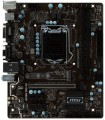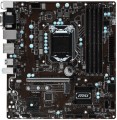Power phases
The number of processor power phases provided on the motherboard.
Very simplistically, phases can be described as electronic blocks of a special design, through which power is supplied to the processor. The task of such blocks is to optimize this power, in particular, to minimize power surges when the load on the processor changes. In general, the more phases, the lower the load on each of them, the more stable the power supply and the more durable the electronics of the board. And the more powerful the CPU and the more cores it has, the more phases it needs; this number increases even more if the processor is planned to be overclocked. For example, for a conventional quad-core chip, only four phases are often enough, and for an overclocked one, at least eight may be needed. It is because of this that powerful processors can have problems when used on inexpensive low-phase motherboards.
Detailed recommendations on choosing the number of phases for specific CPU series and models can be found in special sources (including the documentation for CPU itself). Here we note that with numerous phases on the motherboard (more than 8), some of them can be virtual. To do this, real electronic blocks are supplemented with doublers or even triplers, which, formally, increases the number of phases: for example, 12 claimed phases can represent 6 physical blocks with doublers. However, virtual phases are much inferior to real ones in terms of capabilities — in fact, t...hey are just additions that slightly improve the characteristics of real phases. So, let's say, in our example, it is more correct to speak not about twelve, but only about six (though improved) phases. These nuances must be specified when choosing a motherboard.
Size (HxW)
Motherboard dimensions in height and width. It is assumed that the traditional placement of motherboards is vertical, so in this case one of the dimensions is called not the length, but the height.
Motherboard sizes are largely determined by their form factors (see above), however, the size of a particular motherboard may differ slightly from the standard adopted for this form factor. In addition, it is usually easier to clarify the dimensions according to the characteristics of a particular motherboard than to look for or remember general information on the form factor. Therefore, size data can be given even for models that fully comply with the standard.
The third dimension — thickness — is considered less important for a number of reasons, so it is often omitted.
DDR4
The number of slots for DDR4 memory sticks provided in the motherboard.
DDR4 is a further (after the third version) development of the DDR standard, released in 2014. Improvements compared to DDR3 are traditional — an increase in operating speed and a decrease in power consumption; The volume of one module can be from 2 to 128 GB. It is this RAM standard that most modern motherboards are designed for; the number of slots for DDR4 is usually
2 or
4, less often —
6 or more.
Max. memory
The maximum amount of RAM that can be installed on the motherboard.
When choosing according to this parameter, it is important to take into account the planned use of the PC and the real needs of the user. So, volumes
up to 32 GB inclusive are quite enough to solve any basic problems and run games comfortably, but without a significant reserve for an upgrade.
64 GB is the optimal option for many professional use cases, and for the most resource-intensive tasks like 3D rendering,
96 GB or even
128 GB of memory will not be a limit. The most “capacious” motherboards are compatible with volumes of
192 GB or
more - they are mainly top-end solutions for servers and HEDT (see “In the direction”).
You can choose this parameter with a reserve – taking into account a potential RAM upgrade, because installing additional RAM sticks is the simplest way to increase system performance. Taking this factor into account, many relatively simple motherboards support very significant amounts of RAM.
HDMI output
The motherboard has its own
HDMI output.
Such an output is intended for transmitting video from an integrated graphics card (see above) or a processor with integrated graphics (we emphasize that it is impossible to output a signal from a discrete graphics card through the motherboard chipset). As for HDMI specifically, it is a combined digital video/audio interface specifically designed to work with HD resolutions and multi-channel audio. Today it is the most common of these interfaces, HDMI support is almost mandatory for video devices that are compatible with HD standards.
The specific capabilities of HDMI vary by version (see below for more details), but in general they are quite impressive — even in the earliest (current today) HDMI v.1.4, the maximum resolution is 4K, and in newer standards it reaches 10K. So in motherboards, the quality of the video transmitted through such an output is often limited not by the interface capabilities, but by the graphics performance of the system.
LAN controller
Model of the LAN controller installed in the motherboard.
The LAN controller provides data exchange between the card and the network port(s) of the computer. Accordingly, both general characteristics and individual features of the network functionality of the "motherboard" depend on the characteristics of this module: support for special technologies, connection quality in case of unstable communication, etc. Knowing the model of the LAN controller, you can find detailed data on it — including including practical reviews; this information is rarely needed by the average user, but it can be useful for online game enthusiasts and for some specific tasks.
Thus, the LAN controller model is specified mainly in cases where it is a rather advanced solution that is noticeably superior to standard models. Such solutions are currently produced mainly under the brands
Intel(middle level),
Realtek(relatively simple models),
Aquntia and
Killer(mostly advanced solutions).
USB 3.2 gen1
The number of native USB 3.2 gen1 connectors provided on the back of the motherboard. In this case, traditional, full-size USB A ports are meant.
USB 3.2 gen1(formerly known as USB 3.1 gen1 and USB 3.0) is a direct successor and development of the USB 2.0 interface. The main differences are a 10-fold increase in the maximum data transfer rate — 4.8 Gbps — as well as higher power supply, which is important when connecting several devices to one port through a splitter (hub). At the same time, peripherals of other versions can be connected to this connector.
The more connectors provided in the design, the more peripheral devices can be connected to the motherboard without the use of additional equipment (USB splitters). There are boards on the market that have
more than 4 USB 3.2 gen1 ports on the back panel. At the same time, we note that in addition to the connectors on the rear panel, connectors on the board itself (more precisely, ports on the case connected to such connectors) can also provide a USB connection. See below for more on this.
PS/2
The number of PS/2 ports provided in the design of the motherboard.
PS/2 is a dedicated port designed to connect exclusively to keyboards and/or mice. The traditional motherboard configuration for a PC provides 2 such ports — for the keyboard (usually highlighted in lilac) and for the mouse (green). However, there are boards with one connector, to which you can connect any of these types of peripherals, to choose from. Anyway, the presence of PS/2 can save the user from having to occupy USB ports for the keyboard / mouse; this is especially useful if you have to deal with a lot of other USB peripherals. On the other hand, for a number of reasons, this connector is considered obsolete and is used less and less; and PS/2 peripherals are produced mainly in the form of USB devices, additionally equipped with PS/2 adapters.
Fan power connectors
The number of connectors for powering coolers and fans provided in the motherboard. A processor cooler is usually connected to such a connector, and fans of other system components — video cards, cases, etc. can also be powered from the "motherboard"; sometimes it is more convenient than pulling power directly from the PSU (at least you can reduce the number of wires in the case). Many modern boards are equipped with
4 or more connectors of this type.

